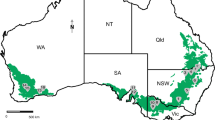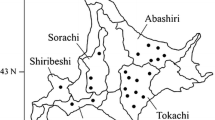Abstract
The random amplified polymorphic DNA (RAPD) method was used to investigate the genetic variability and population structure of Fusarium culmorum isolated from wheat stem bases. A total of 108 isolates, representing seven geographically distinct populations, was collected from five climatic regions in Tunisia. Pseudo-allelic frequencies were estimated at each of the 25 putative RAPD loci analyzed by scoring for the presence or absence of amplified fragments; 92 haplotypes were found among the 108 strains. The analysis of the population structure did not reveal any trend with regard to geographic origin. Total gene diversity (HT * = 0.318) was mostly attributable to diversity within populations (HS * = 0.308). Analysis of molecular variance confirmed that most of the genetic variability was within populations. Genetic differentiation among populations was low to moderate (GST * ranged from 0 to 0.190 and averaged 0.041 over all loci). Cluster analysis with UPGMA using genetic distances did not reveal any spatial clustering of the isolates collected from the different geographic regions. Based on these results, we conclude that the F. culmorum isolates recovered from different regions in Tunisia might be part of a single population pool.
Similar content being viewed by others
References
Borchardt DS, Welz HG and Geiger HH (1998) Genetic structure of Setosphaeria turcica populations in tropical and temperate climates. Phytopathology 88: 322-329
Bortoli L, Gounot M and Jacquinet JC (1969) Climatologie et Bioclimatologie de la Tunisie septentrionale. Annales de l'INRA Tunisie 42: 1-23
Burgess LW and Griffin DM (1967) Competitive saprophytic colonization of wheat straw. Annals of Applied Biology 60: 137-142
Burgess LW, Summerell BA, Bullock S, Gott KP and Backhouse D (1994) Laboratory Manual for Fusarium Research. 3rd edn, University of Sydney, Australia
Champion R (1997) Identifier les champignons transmis par les semences, INRA, Paris
Cook RJ (1968) Influence of oats on soil-borne populations of Fusarium roseum f. sp. cerealis 'Culmorum'. Phytopathology 58: 957-960
Cook RJ (1980) Fusarium foot rot and its control in the Pacific northwest. Plant Disease 64: 1061-1066
Dusabenyagasani M, Dostaler D and Hamelin RC (1999) Genetic diversity among Fusarium graminearum strains from Ontario and Quebec. Canadian Journal of Plant Pathology 21: 308-314
Excoffier L, Smouse PE and Quattro JM (1992) Analysis of molecular variance inferred from metric distances among DNA haplotypes: application to human mitochondrial DNA restriction data. Genetics 131: 479-491
Gargouri S, Hajlaoui MR, Guramech A and Marrakchi M (2001) Identification des espèces fongiques associées à la pourriture du pied du blé et leur répartition selon les étages bioclimatiques. EPPO/OEPP Bulletin 31: 499-503
Ghodbane A, Mahjoub M, Djerbi M, Mlaiki A and Sharen AL (1974) Etude des pertes causées par les pathog ènes dublé Septoria tritici et Fusarium spp. Rapport annuel du ministère de l'agriculture, office des céréales, Tunisie
Goodwin SB, Saghai Maroof MA, Allard RW and Webster RK (1993) Isozyme variation within and among populations of Rhynchosporium secalis in Europe, Australia and the United States. Mycological Research 97: 49–58
Gordon TR and Martyn RD (1997) The evolutionary biology of Fusarium oxysporum. Annual Review of Phytopathology 35: 111–128
Groth JV, McCain JW and Roelfs AP (1995) Virulence and isozyme diversity of sexual versus asexual collections of Uromyces appendiculatus (bean rust fungus). Heredity 75: 234–242
Huff DR, Bunting TE and Plumley KA (1994) Use of random amplified polymorphic DNA markers for the detection of genetic variation in Magnaporthe poae. Phytopathology 84: 1312–1316
Kistler HC and Miao VPW(1992) Newmodes of genetic changes in filamentous fungi. Annual Review of Phytopathology 30: 131–152
Mc Dermott JM, McDonald BA, Allard RW and Webster RK (1989) Genetic variability from pathogenicity, isozyme, ribosomal DNA and colony color variants in populations of Rhynchosporium secalis. Genetics 122: 561–565
McDonald BA, Pettway RE, Chen RS, Boeger JM and Martinez JP (1995) The population genetics of Septoria tritici (teleomorph Mycosphaerella graminicola). Canadian Journal of Botany 73: S292–S301
Miedaner T (1997) Breeding wheat and rye for resistance to Fusarium diseases. Plant Breeding 116: 201-220
Miedaner T, Gang G and Geiger HH (1996) Quantitative-genetic basis of aggressiveness of 42 isolates of Fusarium culmorum for winter rye head blight. Plant Disease 80: 500-504
Miedaner T and Schilling AG (1996) Genetic variation of aggressiveness in individual field populations of Fusarium graminearum and F. culmorum tested on young plants of winter rye. European Journal of Plant Pathology 102: 823-830
Migheli Q, Berio T, Gullino ML and Garibaldi A (1995) Electrophoretic karyotype variation among pathotypes of Fusarium oxysporum f. sp. dianthi. Plant Pathology 44: 308-315
Möller EM, Bahnweg G, Sandermann H and Geiger HH (1992) A simple and efficient protocol for isolation of high molecular weight DNA from filamentous fungi, fruit body and infected plant tissue. Nucleic Acids Research 20: 6115-6116
Molnar A, Sulyok L and Hornok L (1990) Parasexual recombination between vegetatively incompatible strains in Fusarium oxysporum. Mycological Research 94: 393-398
Morris PF, Connolly MS and St Clair DA (2000) Genetic diversity of Alternaria alternata isolated from tomato in California assessed using RAPD. Mycological Research 104: 286-292
Nei M (1973) Analysis of gene diversity in subdivided populations. Proceedings of the National Academy of Sciences, USA 70: 3321-3323
Nei M and Chesser RK (1983) Estimation of fixation indices and gene diversities. Annals of Human Genetics 47: 253-259
Nei M and Li WH (1979) Mathematical model for studying genetic variation in terms of restriction endonucleases. Proceedings of the National Academy of Sciences, USA 76: 5269-5273
Nicholson P, Jenkinson P, Rezanoor HN and Parry DW (1993) Restriction fragment length polymorphism analysis of variation in Fusarium species causing ear blight of cereals. Plant Pathology 42: 905-914
Nijs M, Larsen JS, Games W, Rombouts FM, Wernars K, Thrane U and Notermans SHW (1997) Variation in random amplified polymorphic DNA patterns and secondary metabolite profiles within Fusarium species from cereals from various parts of the Netherlands. Food Microbiology 14: 449-457
Ouellet T and Seifert KA (1993) Genetic characterization of Fusarium graminearum strains using RAPD and PCR ampli-fication. Phytopathology 83: 1003-1007
Schilling AG, Möller EM and Geiger HH (1994) RAPDs of Fusarium culmorum and F. graminearum: Application for genotyping and species identification. In: Schots A et al. (eds) Modern Assays for Plant Pathogenic Fungi (pp 47-56) CAB International, Oxford, UK
Schilling AG, Möller EM and Geiger HH (1996a) Polymerase chain reaction-based assays for species specific detection of Fusarium culmorum, F. graminearum, and F. avenaceum. Phytopathology 86: 515-522
Schilling AG, Möller EM and Geiger HH (1996b) Molecular differentiation and diagnosis of the cereal pathogens Fusarium culmorum and F. graminearum. Sydowia 48: 71-82
Schilling AG, Miedaner T and Geiger HH (1997) Molecular variation and genetic structure in field populations of Fusarium species causing head blight in wheat. Cereal Research Communications 25: 549-554
Schneider S, Roessli D and Excoffier L (2000) Arlequin ver. 2.000: A Software for Population Genetics Data Analysis, Genetics and Biometry Laboratory, University of Geneva, Switzerland
Smiley RW and Patterson LM (1996) Pathogenic fungi associated with Fusarium foot rot of winter wheat in the semiarid Pacific Northwest. Plant Disease 80: 944-949
Sneath PHA and Sokal RR (1973) Numerical Taxonomy, W. H. Freeman, San Fransisco
Sokal RR and Rohlf FJ (1981) Biometry, 2nd edn, W.H. Freeman, San Fransisco
Tuskan GA, Walla JA and Lundquist JE (1990) Genetic-geographic variation in Peridermium harknessii in the Northcentral United States. Phytopathology 80: 857-861
Van de Peer Y and De Wachter R (1994) Treecon for Windows: a software package for the construction and drawing of evolutionary trees for the Microsoft Windows environment. Computer Applications in the Biosciences 10: 569-570
Welsh J and McClelland M (1990) Fingerprinting genomes using PCR with arbitrary primers. Nucleic Acids Research 18: 7213-7218
Wiese MV (1987) Compendium of Wheat Diseases. 2nd edn, American Phytopathological Society, St. Paul, MN
Williams JGK, Kubelik AR, Rafalski JA and Tingey SV (1990) DNA polymorphisms amplified by arbitrary primers are useful as genetic markers. Nucleic Acids Research 18: 6531-6535
Wong A, Forbes MR and Smith ML (2001) Characterization of AFLP markers in damselflies: prevalence of codominant markers and implications for population genetic applications. Genome 44: 677-684
Yli-Mattila T, Paavanen S, Hannukkala A, Parikka P, Tahvonen R and Karjalainen R (1996) Isozyme and RAPD-PCR analyses of Fusarium avenaceum strains from Finland. Plant Pathology 45: 126-134
Author information
Authors and Affiliations
Rights and permissions
About this article
Cite this article
Gargouri, S., Bernier, L., Hajlaoui, M.R. et al. Genetic Variability and Population Structure of the Wheat Foot Rot Fungus, Fusarium culmorum, in Tunisia. European Journal of Plant Pathology 109, 807–815 (2003). https://doi.org/10.1023/A:1026137817723
Issue Date:
DOI: https://doi.org/10.1023/A:1026137817723




